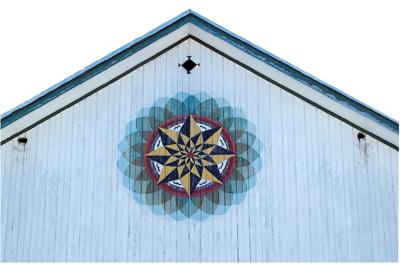If you’ve ever driven through Pennsylvania Dutch country, chances are you’ve seen either hex signs, barn stars or both.
But do you know the difference between the two or how each tradition came to be?
“It’s important to recognize that there really are two parallel traditions,” said Patrick Donmoyer, director of the Pennsylvania German Cultural Heritage Center at Kutztown University. “There are the barn stars, and then there are the hex signs.”
Barn stars, seen throughout south-central and southeastern Pennsylvania, are geometrical, featuring often either six, eight or 12-point stars.
“The term that people typically used was schtanne, which means stars,” Donmoyer said.
While stars on barns are easy to see, mainly due to their large size, similar schtanne were featured on a variety of objects in Pennsylvania Dutch culture, such as wooden chests, marriage licenses and even tombstones.
Star designs painted on barns date back at least to the early 1800s. The early stars were smaller than today’s, and they included the date when the barn was built.
It was around 1830 when large stars started being painted on the fronts of barns.
Within the Pennsylvania Dutch community, stars were seen as beacons of divine order and had agricultural and religious significance.
Farmers’ almanacs often followed star signs to guide agriculture.
However, the emblems were not painted to ward off the supernatural, as many people think today.
“These were part of the agricultural lifestyle,” Donmoyer said. “They were something that was not necessarily connected to supernatural events or ideas.”
Since barn stars had nothing to do with the supernatural, how did hex signs come into play?
“People did not call them hex signs until the 20th century,” Donmoyer said. “The term hex sign has led to a wide range of misperceptions.”
The idea of hex signs came about in 1924, after New England artist Wallace Nutting visited Pennsylvania Dutch country and misunderstood a few traditions.

A hex sign painted by Rachel Yoder, featuring distelfink and tulips.
While in Pennsylvania, Nutting learned about hexenfoos, or witch’s foot, which were small markings made on barn doors — often in the shape of a goose’s foot — that were etched to protect the barns.
Nutting also saw barn stars while visiting, and mistakenly combined the two traditions, calling the barn stars hex signs.
“He was describing something real, but what he was describing was misunderstood,” Donmoyer said. “It was not the stars on the barn that he was describing, it was actually this idea of the hexenfoos. He kind of transposed the two aspects of the tradition.”
Hex signs became popular thanks to Johnny Ott and Jacob Zook.
Ott decided to capitalize on the tourists’ ideas of hex signs and started painting them in the 1950s, often incorporating designs like the distelfink — meaning thistle finch — and tulips.
Zook started mass-producing Ott’s designs as silk screens, which helped turn hex signs into the popular souvenir they are today.
“That has become its own art form unto itself,” Donmoyer said.
As for the barn stars, Milton Hill was one of the best-known painters for the schtanne. He started painting them in 1902 at the age of 14 and even passed on the tradition to his children.
Today, Eric Claypool is the leading painter of barn stars, with over 100 painted in the past 50 years.
While barn stars and hex signs are two different traditions, both originated in the Pennsylvania Dutch culture and evolved over the years to become what they are today.



